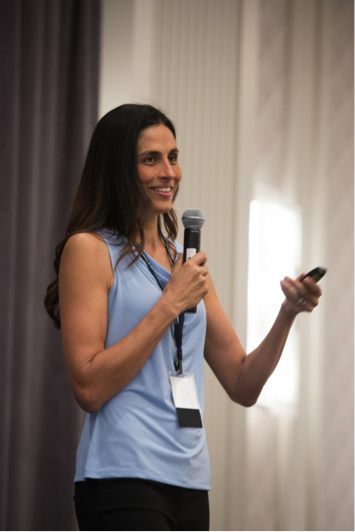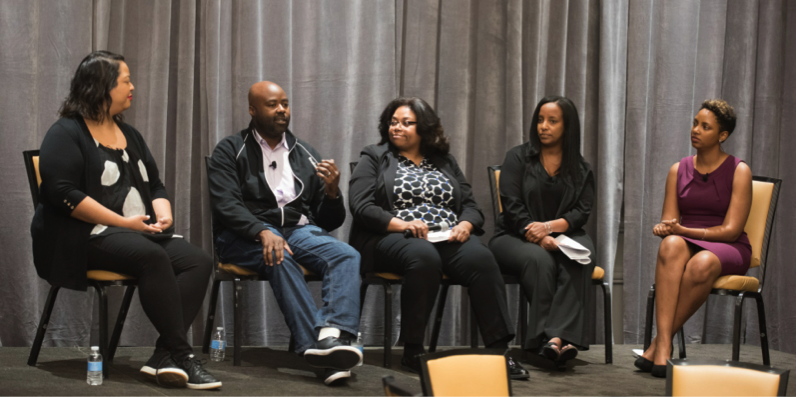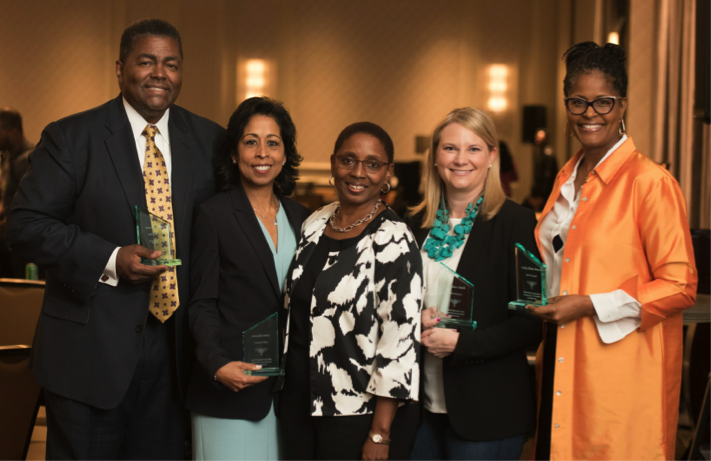Expanding the Pipeline: The 2016 ACM Richard Tapia Celebration of Diversity in Computing Shows Inclusion Matters
About the Center for Minorities and People with Disabilities in IT (CMD-IT)
The vision of CMD-IT is to address the national need for an effective workforce in computing and IT through inclusive programs and initiatives focused on minorities and people with disabilities. CMD-IT’s mission is to insure that underrepresented groups are fully engaged in computing and IT and to promote innovation that enriches, enhances, and enables underrepresented communities. CMD-IT hosts the annual ACM Richard Tapia Celebration of Diversity in Computing conference, and organizes programs focused on professional development, community enrichment, and information dissemination. For more information, please visit www.Cmd-it. org.
Get Involved
Encourage undergraduate and graduate students, professionals, researchers, and faculty to participate in the Richard Tapia Celebration in 2017. Sponsorship and scholarship opportunities will be available. For more information, please visit www. tapiaconference. org.
2016 ACM Richard Tapia Celebration of Diversity in Computing
The 10th annual ACM Richard Tapia Celebration of Diversity in Computing (hashtag #Tapia2016) was held in Austin, Texas, on September 14-17. This year’s conference had a record-breaking 965 attendees, achieving 20 percent growth over 2015. Eighty sponsors and 150 colleges and universities were represented. With the theme “Diversity Matters,” the Tapia conference brought together students, faculty, researchers, and professionals from all backgrounds and ethnicities in computing, and is the premier venue to promote and celebrate diversity in the field. The Tapia conference was sponsored by the Association for Computing Machinery (ACM) and presented by the Center for Minorities and People with Disabilities in IT (CMD-IT).
 Program highlights included plenary presentations by Raquel Romano, senior software engineer, Google, who presented “Redefining Inclusion: Technology as an Act of Service”; Melanie Moses, associate professor of computer science, University of New Mexico, who gave a talk titled “Emergence, Cooperation and Diversity: The Evolution of Natural and Engineered Swarms.” Plenary speaker Daniel Sonnenfeld, technical program management director, Salesforce, delivered his talk, “Overcoming Barriers for Careers in Information Technology,” in American Sign Language. The Ken Kennedy Distinguished Lecture, titled “Scientific Computing in the Movies and Virtual Surgery,” was delivered by Joseph Teran, professor of applied mathematics, UCLA. The plenary panel, “Shifting the Paradigm: A Dialogue with Chief Diversity Officers,” featured Lesley Slaton Brown, chief diversity officer, HP, Inc; Gwen Houston, chief diversity officer and general manager, Global Diversity and Inclusion, Microsoft; Drew Valentine, vice president, People and Culture, IBM Analytics; and Meghan Welch, chief diversity and inclusion officer, senior vice president, Human Resources, Capital One.
Program highlights included plenary presentations by Raquel Romano, senior software engineer, Google, who presented “Redefining Inclusion: Technology as an Act of Service”; Melanie Moses, associate professor of computer science, University of New Mexico, who gave a talk titled “Emergence, Cooperation and Diversity: The Evolution of Natural and Engineered Swarms.” Plenary speaker Daniel Sonnenfeld, technical program management director, Salesforce, delivered his talk, “Overcoming Barriers for Careers in Information Technology,” in American Sign Language. The Ken Kennedy Distinguished Lecture, titled “Scientific Computing in the Movies and Virtual Surgery,” was delivered by Joseph Teran, professor of applied mathematics, UCLA. The plenary panel, “Shifting the Paradigm: A Dialogue with Chief Diversity Officers,” featured Lesley Slaton Brown, chief diversity officer, HP, Inc; Gwen Houston, chief diversity officer and general manager, Global Diversity and Inclusion, Microsoft; Drew Valentine, vice president, People and Culture, IBM Analytics; and Meghan Welch, chief diversity and inclusion officer, senior vice president, Human Resources, Capital One.
The conference’s closing banquet was highlighted by an inspiring keynote address by Richard Tapia, Maxfield-Oshman Professor in Engineering at Rice University and the conference namesake. His speech reviewed his career from the beginning, when he was the first member of his family to attend college, to his receipt of the National Medal of Science, the highest national honor for a U.S. scientist, from President Barack Obama.
The Richard A. Tapia Achievement Award for Scientific Scholarship, Civic Science and Diversifying Computing award was presented to David Patterson, Pardee Professor of Computer Science, Emeritus at the University of California at Berkeley. The award honors an individual who demonstrates significant leadership, commitment, and contributions to diversifying computing.
The Tapia conference featured 18 panels and workshops and 17 birds-of-a-feather sessions. The Tapia conference poster competition included 48 graduate and undergraduate posters. There were 240 scholarship recipients and 14 doctoral consortium participants. The Tapia Conference hosted a career fair during the conference that featured more than 80 universities, national laboratories, government agencies, corporations, and nonprofits, as well as an industry poster session, which provided an opportunity for conference participants to learn about career paths and/or diversity initiatives at organizations that are Tapia conference sponsors. The career fair was attended by 534 students–351 undergraduates and 184 graduate students–in addition to other conference participants.
What Attendees Learned
Some of the key learnings in diversity from the conference included:
- It is important for corporations to train everyone in issues relating to accessibility. One example highlighted during the fireside chat: “Using Technology and Social Media to Diversify Computing” was given by Damien Peters, product manager, Facebook, who spoke about the company’s empathy labs that enable Facebook employees to understand how Facebook is experienced by the visually impaired. Giving employees this experience enables the company to deliver products that work for everyone.

- It is critical to be aware how easy it is to take access and networks for granted. Also, it is vital to constantly create opportunities for students and employees to have access to education (including funding), employment, and advances in technology.
- It is important to recognize that a diverse workforce is more attractive to corporate customers who ask, “Do you have people like me who understand my issues?” (source: IBM) Examples of efforts to build and retain a diverse workforce discussed during the plenary panel “Shifting the Paradigm: A Dialogue with Chief Diversity Officers” included creating a diverse board of directors (HP); creating a broad suite of benefits that enable employees to create the benefit package that works best for their situations (HP); developing a culture that recognizes that ideas can come from anywhere and making sure that all voices are heard and matter (Capital One); and creating employee resource groups and underwriting communities that can provide a supportive environment for employees (Microsoft).

- In addressing issues around employees with disabilities to assure their inclusion, Microsoft has introduced the role of chief accessibility officer to create visibility for issues around accessibility in the C-suite. In his plenary talk, which was delivered in American Sign Language, Daniel Sonnenfeld of Salesforce highlighted that, as his career has advanced, technology has evolved as well. He recommended that organizations need to actively recruit applicants to apply from all backgrounds and proactively ask applicants if they need any kind of accommodations for the interview process.
- It is vital to recognize the an ongoing issues of conscious and unconscious bias. “Bias Busters @ University Workshop: A Carnegie Mellon/Google Collaboration to Address Unconscious Bias” highlighted the fact that inclusion needs allies to make changes happen. Exposing more people in both academia and industry to these workshops helps to recruit more allies to support diversity.
- Many organizations are focusing their investments in the future of computing on interventions at the K-12 level to increase access to technology in underserved communities. The “Engaging Students of Color in Computer Science” panel discussed successful practices for engaging children in underserved communities, including basing projects on social justice–i.e., projects that will uplift the community the students live in, promote social support through both peer and mentor relationships, and engage the community, including parents and other family members, as the programs progress.
The critical questions raised early in the Tapia conference were what efforts will move the needle to generate more diversity in all areas of technology and what methods will be necessary to sustain the advancement of these efforts. The above panels and discussions are merely a short list of some of the efforts highlighted during the conference. Moving forward, CMD-IT and the Tapia conference will continue to focus their efforts on increasing diversity in technology. The Tapia conference website mentions some of the reasons why diversity is important:
- Diversity matters for innovation: Solutions derived from restricted, homogenous perspectives are likely to be sub-optimal often missing key insights necessary for broader, more impactful, simply better outcomes.
- Diversity matters for knowledge: When we join forces with diverse disciplines, the mergers of computational thinking with other scientific and artistic domains can render unique and compelling solutions that help us tackle the hardest problems facing our world.
- Diversity matters for life: Computing advances do not occur in a vacuum; they are not disconnected from our societal challenges. Both science and society benefits when we enable people from all groups to leverage their talents and passions to explore novel ways to change the world.
The next ACM Richard Tapia Celebration of Diversity in Computing will take place from September 20-23, 2017 in Atlanta, Georgia.
About the Author
Jerri Barrett is a marketing professional who has worked in the technology industry for almost 30 years. She is currently vice president of outreach for a biotech-focused nonprofit and provides marketing and public relations support to CMD-IT. Previously, Barrett was the vice president of marketing of the Anita Borg Institute and a marketing executive at tech startups IP Unity, HighWired, and LinkAir, as well as Glenayre, Nortel, and Frontier. Barrett has an MBA from the University of Rochester’s William E. Simon Graduate School of Business Administration and a BA from Mount Holyoke College.









